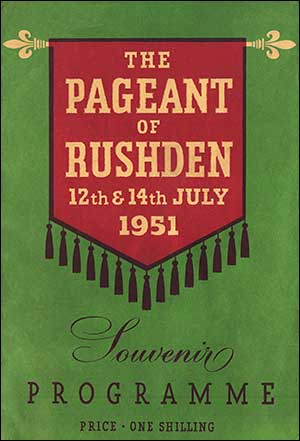 |
CIVIC FOREWORD
THE Festival of Britain is in full stride. Throughout the length and breadth of the land its spirit is finding expression in a variety of ways to portray the British way of life.
In common with almost every other town and hamlet Rushden has attempted something worthy of its people and their talents. It has tried to cater for the young and the aged—and for every taste.
The author of the PAGEANT OF RUSHDEN has produced a remarkable story of Rushden through the ages. Its simple theme is Rushden and its people, and such a theme is bound to bring to light some interesting facts—episodes which will no doubt prove to be intriguing as well as entertaining. It will tell the story of Rushden from early beginnings when it was just an obscure hamlet down to the present time, when it is an industrious and vigorous town, pulsating with community life.
The aim of the Pageant is not purely one of entertainment, but we hope it will bring some enrichment to the community life of this town that will endure for long after the Festival celebrations are over.
|
|
May I take this opportunity of commending this "show" to you and to extend very grateful thanks to the Author and to all those who have given of their time and talents to these festive arrangements. I feel certain that the townspeople of Rushden will respond wholeheartedly- and show their tradi¬tional appreciation of Rushden's programme for the Festival of Britain.
CYRIL G. FAULKNER,
Chairman, Rushden Urban District Council.
|
|
INTRODUCTION
THOSE who suggested that Rushden should prepare a pageant for Festival Year may not have paused to consider the stuff of which the conventional pageant is made. Perhaps they never thought that a battle here, an execution there, some famous rite, procession or pilgrimage, or at the least a personage whose celebrated name could be read at some modern street corner had always been the essential material of a script.
Let them not worry as they look in vain for crown or chopping-block, or as the passing story reveals only the life and characters of a quiet village that was for several centuries even obscure. Let them rejoice, as the author has done, to break into the unconventional; to find room for the gentler side of history; to observe how a useful, industrious town can evolve from simple living; to feel that some remote incident or celebrity need not be quoted or canonized as a justification for our survival.
That last thought was innocent of malice. It meant, in conjunction with the others, that because our historical material is slight and fragmentary, we are able to sketch with a free hand and picture scenes and people whose place in the facade may savour of freshness or surprise. We have room, if not absolute need, to stretch a point or take a flight of fancy. With no heavy convention to shock, we can be less than pompous in our technique and assumptions. We can even call our pageant a "show" and welcome a smile.
The author would stress, however, that as early as the second scene he is building around established facts; that from the third scene to the final ensemble each glimpse of yesteryear is authentic in its essentials. Local writings and records, the valuable data collected by Mr. A. Norman Groome, and suggestions made verbally have gone into the structure of what, it is hoped, will be an entertainment, a record—dramatised for the first time in Rushden's history—and a tribute to the men and women from whose typically English character and customs the good, well-ordered town of shoemakers has sprung.
Many have co-operated since the first spot of ink was shed in November, 1950. All, it is believed, have done so in the wholesome spirit of citizenship and with a thought for brightening the times. They probably think, with the author, that if Rushden gains in prestige from what has been attempted, no more than justice will have been done.
|
|
For the first time in history Rushden presents its story in dramatised form, with musical, spectacular and comedy features.
Well over 300 players appear in eight varied and fascinating scenes, with massed finale, on the greensward at The Hall.
Specialities include Hunting Scene (with the Oakley pack), Elizabethan Madrigals, May Day Revels and novel Shoe Ballet
1,650 SEATS AVAILABLE FOR EACH PERFORMANCE
Forward Rows: 5s. if booked before day of performance;
6s. on day. All Other Seats : 3s. in advance, 4s. on day.
Promenade Tickets : : : Thousands available at 2s.
Children : Half-price in seating enclosure if accompanied by adults. Half-price to promenade area.
|
|
|
|
ADVANCE BOOKING
All tickets on sale at
"Evening Telegraph"
Offices, Wellingborough,
Rushden and Kettering
|
|
ENTRANCES
High Street South, Hall
Avenue and Western Gate
(Wymington Road entrance will be closed)
|
|
AMPLE FREE CAR PARK : HALL AVENUE ENTRANCE
|
|
Narrator: JOHN STURGESS
Incidental Music: RUSHDEN TEMPERANCE BAND
(Conductor: WILLIAM SCHOLES)
The Setting The arena covers 10,000 square feet on a gentle rise, giving a full view to every spectator. A main piece designed by S. G. Ette and painted by Rushden Sketch Club will represent, as occasion demands, the Village Inn or the Hunting Lodge at Higham Park. In Scenes 1, 2, 6 and 7 the audience will disregard its intrusion and look rather to the lovely background of foliage, with which has been blended a screen of tree-tops to conceal "off-stage" activities. Other scenic pieces will be added as required.
The Narrative Passages in rhyme will introduce and link the episodes, adding appreciably to the "web of memory." Each scene is an independent vignette, but as the centuries are traversed a story of advancement builds-up from impressions.
The Music Apart from the overture, the frequent fanfares, one modern dance and a final chorus, the music is largely that of the Elizabethan madrigalists, G. F. Handel, and traditional and local song and dance sources. There are short entr'actes, and the Ancient Britons have their own comedy theme.
The Costumes All are accurately and colourfully representative of the 300 characters in the Pageant. Local designers have created many of the costumes, and others have been obtained from the well-known London costumiers, C. I. Samuels, Ltd.
Sound Distribution Through numerous microphones and loud-speaker tower installed by R. L. Timms, Northampton.
|
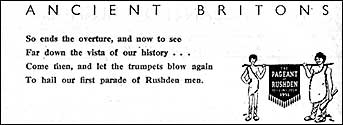 |
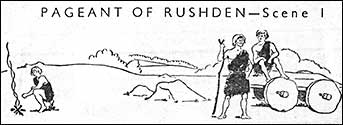 |
We can only assume that members of the ancient Coritani tribe would wander this way—perhaps with their primitive non-jet vehicles. If they did, they would probably halt for a snack, and their joint of . brontosaurus would certainly be bigger than our modern joint of—whatever it is. And why should they not have been looking for Wobblingbarrow or Wymington (Town of Women)!
For our purpose, however, they are not to be taken seriously. They seem, in their curious way, to have got Present and Future all mixed up, and, frankly, we cannot accept their preposterous theory about the origin of leather and boots.
The best thing, it appears, is to hurry them off and avoid confusion. If any of them should by some mysterious means return in later centuries, we can only hope they will be as observant and orderly as possible.
|
PLAYED BY RUSHDEN O. S. & MISSION O. S.
|
|
|
| *First Ancient Briton |
|
William Clarke |
| *Second Ancient Briton |
|
Don Sturgess |
*These characters re-appear as the Pageant proceeds
Other Ancient Britons:
William Ainge, Arthur Frost, Robert Wilkins.
The Heralds:
Played throughout the Pageant by Margaret Harris, Pauline Bailey and others.
The Overture:
Composed for the Pageant by L. V. Elliott and arranged for brass band by William Scholes, the Overture springs from a hunting strain, moves into passages suggesting the romance of old times, and, after another hunting call, takes the form of a country dance. Some bells are heard, and the closing section is built upon an old maypole song.
|
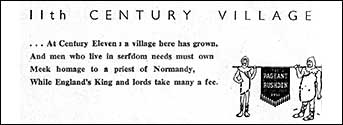 |
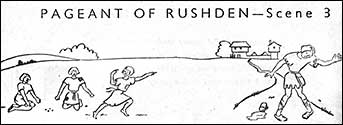 |
This is the point at which we stick our teeth fairly and squarely into local history, for Domesday Book gave us definite records of the village, its land and certain establishments.
The liberty of the subject was not then a matter of great concern, and the people were little more than slaves under the local rule of an autocratic bailiff, who in turn had plenty of overlords, among them the Bishop of Contances, in Normandy, to whom heavy dues were payable.
In our scene some yokels reveal something of the toil, disease and ignorance which marked those days, and other characters draw some comparison with the more consequential status of neighbouring Hecham.
To relieve what might have been a gloomy picture the day is rated as a holiday—especially for the children—and the bailiff is caught in one of his weaker but perhaps more humane moments.
|
PLAYED BY Y.M.C.A. DRAMATIC GROUP
| William |
|
Don Wildman |
| Harold |
|
David James |
| The Bailiff |
|
John Wilmott |
| Ralph |
|
Brian Oliver
|
| Bailiff's Wife |
|
Marion Smith |
|
|
|
| Villagers: |
|
|
| Robert Clark, Brenda Settles, Joyce Settles. |
|
|
|
| Risdene Children: |
|
|
| Marian Bayliss, Patricia Bazely, Maisie Blenco, Michael Bunning, Janet Cutmore, Margaret Desborough, John Dickenson, Daphne Dilley, Kathryn Ellson, Lorna Foster, Patricia Hart, John Higgins, Margaret Hilson, Carol Hull, Pat Ingram, Gillian Patenall, John Payne, Colin Pott, Michael Pott, Robert Rawlings, Monica Rowe, Jean Surridge, Patricia .Travill, Barry Whitney, Janet Whyman, and Clive Wood. |
|
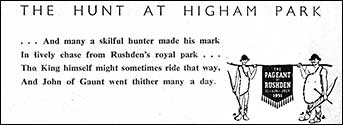 |
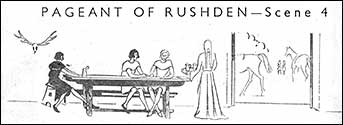 |
Here, at any rate, we come close to the familiar type of pageantry, taking in a famous figure and an equally famous British sport.
In the time of John of Gaunt, Hisham Park was, as now, part and parcel of Rushden. Heavily stocked with game, it extended to 600 acres within a continuous hedge and ditch ("The Border") and had a large moated lodge, complete with chapel, bakehouse, brewhouse and smithy. There were two drawbridges.
The Duke of Lancaster (John of Gaunt), whose second wife was daughter of the King of Spain, hunted from the lodge when in residence at Hisham Castle. At the time of our scene (dated 1372) the spire had just been added to the parish Church of "Ryssheden."
Authentic characters, place-names and local colour come readily into the dialogue. The journey of the hay cart, the granting of bucks and an oak tree to Sir William Croyser, the repair of the mills and the violent poaching affair led by Stephen Bailey, of Rothwell, spring from the records of the period.
The Hunt prospered for many years, and the Park was never ploughed until the time of the Civil Wars. |
PLAYED BY RUSHDEN OPERATIC SOCIETY
|
|
|
| Robert the Falconer |
|
Sidney Bailey |
| Roger Knight |
|
Ivor Francis |
| Joan |
|
Rose Drage |
| The Huntsman |
|
George Dangerfield |
| Hubert |
|
Tom Daniels
|
| Sir William Croyser |
|
Percy House |
| Lady Croyser |
|
Pauline Farey |
| John of Gaunt |
|
John Corbett |
| John Beresford |
|
George Johnson |
|
|
|
| Serving Maids and Hunt Servants: |
|
Audrey Cave, Phyllis Clarke, Vera Denton, Rose Frost, Norah Gibbs, Bertha Harbour, Rita Yeomans, Graham Norris, Victor Parsler, Albert Sanders, Geoffrey Sanders.
|
|
|
|
| Members of Hunt: |
|
|
A. J. Adams, Mick Brown, John Campion, Fred Chambers, Tony Chambers, Josephine Green, Arthur Griggs, Shirley Hobbs, Sarah Hollis, Doreen Maple, Ruth Sanders, Don Smith, Pam Taylor, Stanley Hardiman (Oakley huntsman), Jim Saville (Oakley whip), with hounds of the Oakley Hunt.
|
|
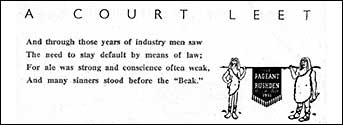 |
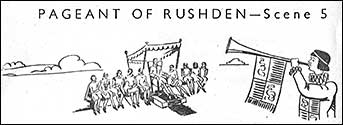 |
Few people realise that Rushden long held its own court of justice, or that records of cases tried—often in the open air—exist in plenty. The tithingmen—each responsible for keeping his neighbours in order—were busy people, and not so virtuous as to escape occasional appearances in the role of defendant. Jurors were equally fallible, and it was nothing unusual for one to return to the jury bench after facing some accusation against himself.
The "Court Leet and Law Day of Ryssheden and the Park" for Michaelmas, 1439, left us some interesting material, for one of the defendants was none other than William Chicheley, of Higham Ferrers, brother of the famous Henry. He had neglected to keep in repair the bridge which then divided Higham and Rushden, and we may imagine this man of culture taking a poor view of the occasion.
An assault case with which the scene opens is also an actual one from the Court Rolls, and the official pronouncements and jurors' names are no less interesting.
Opportunity has been taken to mention the Leper Hospital of St. James, which stood for centuries near the Rushden-Higham boundary, and "Bung Eddy," the ghost of lonely Spital Hill (now Higham Road).
|
PLAYED BY THE REJECTS' CLUB
|
|
|
| Bailiff |
|
Alan Bonham |
| Steward |
|
Bob Crooke |
| William Man, jnr. |
|
Roger Boyd
|
| Walter Knotte (a Tithingman) |
|
Ian Smith |
| Edmund Masonn |
|
Peter Valentine |
| Robert Chapman |
|
Marshall Martin |
| Margery Masonn |
|
Vera Eardley |
| Thomas Barret (Tithingman) |
|
Derek Loakes |
| William Chicheley |
|
Gerald Neville |
| Innkeeper |
|
Bob Dunn
|
|
|
|
|
|
|
|
|
|
|
Jurors, Villagers, etc.:
|
|
|
| Douglas Adams, Neil Bonham, Keith Bradshaw, John Clifton, Brian Collins, Margaret Craddock, Derrick Faulkner, Mina Langcake, Geoffrey Martin, Sheila Martin, Sheila Matson, Madge Penniss, Marlene Perkins, Alan Tanners, Brian Ward, Marion Wilson, Peter Wilson. |
|
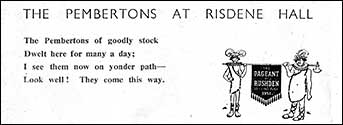 |
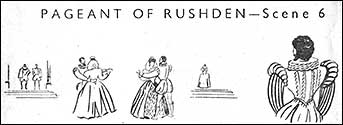 |
Not for the first time in its history, Rushden Hall is in need of restoration, and the town rejoices to know that the necessary work may begin during Festival Year.
At the time of our Elizabethan scene Robert Pemberton had lately rebuilt and enlarged -the house following a disastrous fire. The Pembertons lived there for 200 years, and we delight to picture the family at the height of its affluence, with Robert—a Gentleman Usher to the Queen—his wife Mary and his brother Sir Goddard, High Sheriff of Hertford, accompanied by relatives, guests, retainers and people of the village.
Robert and Mary's children—some of. the -eight portrayed on the monument in St. Mary's Church were yet unborn—walk with the ciders through the park. Dances are called, and the Elizabethans weave their madrigals with a degree of skill that is prophetic of Rushden's present standing in music.
|
PLAYED BY THE ST. CECILIA SINGERS
|
|
|
| Robert Pemberton |
|
Frank Wilmer |
| Mary Pemberton |
|
Vera Hardwick |
| Sir Guy Randle |
|
Sidney Hudson |
| William |
|
Ernest Lack
|
| Rector of Risdene |
|
Sydney Pratt |
| Sir Coddard Pemberton |
|
Peter Randall |
| Lady Randle |
|
Hilda Bunker |
|
|
|
| The Pemberton Children: |
|
|
| Stephen Bayes, Doreen Bunker, Donald Pratt, Jean Randall, Kathleen Randall, Roy Wilmer. |
|
|
|
| Guests, Retainers and Villagers: |
|
|
Elsie Adams, Edith Barnes, Dora Bayes, Sheila Childs, Ivy Clark, Millicent Dickens, Hilda Groome, Mildred Groome, Gwyneth _ Jones, Lilian Knight, Joan Linger, Joan Maddams, May Margetts, Kathleen Nuttycombe, Maud Parker, Monica Spicer, Vera Thornton, Doreen Timpson, Myrtle Underwood, Margaret Warren, Ethel Whitehead, Thelma Whiting, Ada Wicks, Eileen Wilcox, Evelyn Williams, Elizabeth Wilson, William Bennett, Donald Binder, Herbert Blackwell, Walter Clark, Edward Durham, Frank Durham, Chris Francis, Reginald Hirons, Arthur Houghton, Llewellyn Jones, Gordon Lambert, Thomas Major, Frank Neal, Joseph Patterson, Archie Randall, Richard Wilmer.
|
|
|
|
| The Madrigals: |
|
|
| "All hail, thou merry month of May" (Byrd) |
| "As Vesta was from Latmos Hill descending" (Weelkes) |
| "All creatures now are merry minded" (Benet) |
|
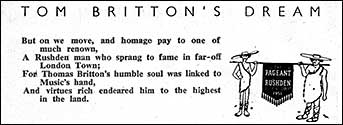 |
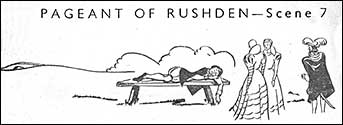 |
For this scene we claim special notice and attention because, through it, Rushden for the first time pays tribute to one of its outstanding characters—the small-coal man who gave London its first concerts and was the friend of great musicians (notably Handel) and the aristocracy of llth Century London.
If our town has hitherto neglected its homage to this remarkable man, there is at least one good reason, for only in recent times did a search of the" parish registers establish Rushden definitely as Britton's birthplace, another town having usually received the credit.
The loft where the concerts were held cannot conveniently be represented in an open-air performance, and our alternative is the dream technique, the scene being a Rushden glade where young Tom, on the eve of his migration to London, falls asleep and into the spell of St. Cecilia. In the dream the life and character of our celebrity are sketched by his contemporaries and Thomas himself appears, as if drawn from the Shades by the lure of Handel's music.
|
PLAYED BY RUSHDEN OPERATIC SOCIETY
|
|
|
| Tom Britton (as a boy) |
|
Alan Edwards |
| John Roper (his playmate) |
|
Keith Toby |
|
|
|
| Dream Characters: |
|
|
| St. Cecilia |
|
Mary Wills |
| An Old Woman |
|
Kathleen Dent |
| Dr. Garenciers |
|
Harold Clayton |
| Sir Roger L'Estrange |
|
Geoffrey Knight
|
| Lady Rochester |
|
Rene Welsford |
| Mr. Overron |
|
Douglas Gilbert |
| Mrs. Britton |
|
Betty Garratt |
| Handel |
|
Patrick Higgins |
|
|
|
| St. Cecilia's Attendants: |
|
|
|
Jacqueline Dilley, Sheila Eaton, Freda Faulkner, Diane Hancock, Jane de Neuman, Elizabeth Smith.
|
|
|
|
| The Music of Handel: |
|
|
| "Where'er you walk"—Sung by Mary Wills |
| "Silent Worship"—Sung by Douglas Gilbert |
| "The Harmonious Blacksmith"—Harpsichord |
| "Largo"—Sung by Operatic Chorus |
|
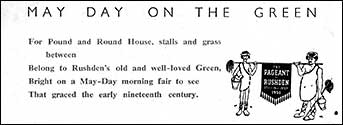 |
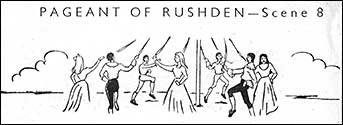 |
In the early 19th Century, Rushden had no more than 800 inhabitants and was not yet conscious of the Industrial movement that within sixty or seventy years would make it one of Northamptonshire's chief towns. The still rural atmosphere lent itself to the simplest forms of social pursuit, and much was made of traditional occasions such as May Day.
According to the late Mr. J. Enos Smith, who was organist at St. Mary's and made local history a hobby, the old-time May Day could be rowdy, especially when village youths raided the back yards and carried off loose properties such as mops and buckets, to lodge them on the coping of the Round House. This now-vanished lock-up stood on the Green, with a pound nearby.
It was- on the Green, too, that the women and children saluted the day more graciously. There would be dancing and singing, the May Queen's procession would appear, and the May Day song associated with Northamptonshire would certainly be heard.
If the Rector appeared and made a little speech, we are sure he would say, as public speakers have never ceased to do, that for a small place Rushden had a great amount of talent.
|
PLAYED BY CENTRAL AND ST. CRISPIN
TOWNSWOMEN'S GUILDS
|
|
|
| Mark (Stallkeeper) |
|
Bob Dunn |
| Dick (Stallkeeper) |
|
John Watts |
| Joe |
|
Patrick Norman |
| Nellie |
|
June Cooper |
| Katie |
|
Lilian Hawes |
| Willie |
|
Harold Nicholson |
| Queen of the May |
|
Janet Haynes |
| Mrs. Brown |
|
Connie Glenn |
| The Rector |
|
Charles Cash |
|
|
|
| May Queen's Attendants: |
|
|
Pat Barnett, Peggy Cherry, Gillian Claridge, Andrea Cutmore, Audrey Dodd, Joyce Draper, Jill Eady, Joan Glenn, Lois Minney, Janice Rankin, Stella Warren,. Christine White.
|
|
|
|
| Maypole Dancers: |
|
|
| Maureen Allen, Janet Bqdill, Pat Bunting, Jennifer Stenson, Judith Cooper, Joan Fensome, Pat Ferguson, Jane Garley, Kathleen Giles, Diana Gramshaw, Jennifer Hancock, Judith Harris, Pat Hart, Joan Millar, Judy Perkins, Diane Sawford, Doreen Sharp, Irene Warhurst. |
|
|
|
| Youths : |
|
|
| Edward Ball, John Burt, Raymond Byford, Michael Drage, James Flanders, Roger Miles, John Warren. |
|
|
|
Other Villagers:
|
|
|
Dorothy Bailey, Kathleen Barnwell, Eliza Bird, Clare Chester, Jennie Clayton, Marian Clark, Doris Cutmore, Hilda Dickens, Daisy Foster, Janet Ferguson, Gwen Freestone, Elsie Gomm, Sheila Greig, Doris Hensman, Ruby Hulatt, Lilian Jackson, Gwendolen Litchfield, Kathleen March, Lily Norman, Lily Penness, Audrey Perkins, Ellen Perkins, Frances Perkins, Vera Sawford, Margaret Sewell, Mabel Stenson, Kit Smith, Helen Thompson, Ruth Tuson, Florence Winters, Lydia Cash.
|
|
|
|
| String Players: |
|
|
| Tony Barker, Herbert George, Cecil Guy, Kara Hall, Olive Lamb, Sydney Seamarks. |
|
|
|
| The Music : |
|
|
| Northamptonshire May Day song |
| Northamptonshire song: "The Sweet Rosy Morning" |
| Dances: "Come lasses and lads," "Begone, dull care" |
|
|
THE FINALE
We need no lesson in the modern history of Rushden, but William Smith, the ageless shoemaker, assisted by the Shoe Ballet and other figures, may well pay tribute to the craftsmanship from which has sprung the country's most intensive centre of boot and shoe manufacture.
The wars of the last century would have provided much dramatic material, but it seems to us that a conflict of atmosphere is best avoided, and for a general token of the spirit that met each trial of the Rushden (and British) character we greet one of the town's oldest Home Front institutions, the St. John Nursing Division, now celebrating its "golden" jubilee.
Before the final ensemble there is a beckoning of youth "to take the good we hold, and build upon it with a courage bold." The Pageant closes with a thought expressed in song . . .
Now from the varied scenes that brought us to this hour Courage we gather for a way unknown. What shall we fear from hooded change or circumstance, What hold in doubt against the past we own? Here have we lived; here may we pledge in faith serene That wells from pages we have turned with pride To honour still the best we know of yesteryear. And lift our hearts to new shores on a glorious tide.
|
THE FINALE
|
|
|
| William Smith (a Shoemaker) |
|
Charles Jones |
| 19th Century Boot Workers |
|
Celia Crick |
|
|
Albert Dickens |
| Closers (19U) style) |
|
Vera Denton |
|
|
Rose Frost |
|
|
Bertha Harbour |
|
|
Norah Cibbs |
| The Motorist |
|
Arthur George |
|
|
|
| Shoe Ballet |
|
|
(from Evening Institute Ballet Class): Pamela Settles, Audrey Darnell, Jacqueline Dilley, Jose Eagle, Sheila Eaton, Pauline Farey, Freda Faulkner, Moyra Groome, Sylvia Haley, Jean Hardwick, Eileen Jowsey, Jill Loakes, Margaret Rees, Molly Terry, Elizabeth Smith.
|
|
|
|
| Youth Column (from Rushden Youth Movement): |
| Pauline de Banke, Roger Boyd, Greta Burt, E. Chamberlain, Derek Chapman, Jean Ellis, Joan Ellis, Rhona Johnson, Joyce Partridge, Pauline Rawlings, Barbara Robinson, Irene Robinson, R. Rogers, J. Smith, Don Wildman, Marion Wilson, T. Woodward. |
|
|
|
| Guard of Honour: |
|
|
|
The Rushden St. John Nursing Division,led by
Superintendent Miss W. M. Clipson.
|
|
| Stage Manager |
|
Leslie Priestley |
| Business Manger |
|
W. H. Imison |
| Chief Wardrobe Mistress |
|
Nellie Hart |
| Scenic and Programme Artist |
|
S. C. Ette |
| Band Director ... |
|
' William Scholes |
| Music Liaison ... |
|
Joan Hart |
| Riding Master ... |
|
Ted Chettle |
| Property Master |
|
Herbert Ingram |
| Assistant Property Master |
|
Clive Daniels |
| Ballet Mistress |
|
Jose Marsh |
| Effects Pianist |
|
Harold James |
| Call Boys |
|
Bryan Bishop |
|
|
Roy Jarvis |
|
|
Robert Safford |
| Chief Steward |
|
Edward Wadsworth |
| Treasurer |
|
W. D. White |
| Hon. Assistant Secretary |
|
Phyllis Bryant |
| Hon. Organiser |
|
L. V. Elliott |
| Wardrobe Mistress (Scene 2) |
|
Rosemary Mackness |
| Drama Leader (Scene 3) |
|
Miss E. M. Orchard |
| Drama Leaders (Scene 8) |
|
Elsie Gomm |
|
|
Sheila Greig |
| Dancing Mistresses (Scene 8) |
|
Janet Ferguson |
| |
|
Dorothy Furniss |
| Choral Numbers prepared by John Cooke, Miss H. Foxworthy, Chris Francis, William Hardwick and Oswald Lawrence. |
| Programme Sellers : Lily Cooke (organiser), Ann Bettles, Joyce Bonham, Beatrice Daniels, Lilian Dickens, Barbara Dudley, May Garley, Ruth Gould, Jean Grayson, Ivy Ingram, Dorothy Johnson, Jenniffer Ladds, Irene Magee, Doreen Perkins, Joan Saddington, Gladys Towers, Audrey Tyler; Enid Warner, Margaret Watson, Stella Wicks, Elizabeth Wilson. |
|
| Acknowledgments |
| Service given by the following is most gratefully acknowledged. |
| Leaders and members of all participating groups. |
| School Managers and Messrs. Eaton & Co. for loan of halls. The head teachers and caretakers for their co-operation. |
| Rushden Evening Institute (Principal : Mr. W. A. E. Sherwood) for many facilities. |
| Mr. B. R. Palmer for planning and directing erection of natural background for arena. |
| Mr. W. E. Capon and office staff of John Cave & Sons, Ltd., for manifolding of scripts. |
| Mr. F. G. Felce (N.P. & P.Co.) for binding scripts. |
| Mr. John White and staff for the Shoe Ballet properties. |
| Mr. Ted Chettle for his practical interest on the equestrian side. |
| Oakley Hunt committee and staff for co-operation in the hunting scene. |
| Mr. S. G. Ette, designer of scenery, programme illustrations and giant "shoes". |
| Rushden Sketch Club members who painted the scenery. |
| Mr. Victor Tarry, of Pytchley, for loan of farm wagon and horse. |
| Mr. J. Willmott, for loan of hay. |
| Messrs. Arthur Sanders, Ltd., and Messrs. H. W. Chapman, Ltd., for supplying scenery and special properties at cost price. |
| Mr. Fountain, of Sharnbrook, for preparing side-saddles. The staff of Rushden Hall Grounds. Programme sellers, stewards and gate staff. |
| Others whose services were solicited after this advance souvenir had gone to press. |
|
|
Printed by : The Northamptonshire Printing and Publishing Co. Ltd., 5, Park Road : Rushden
|
|
|